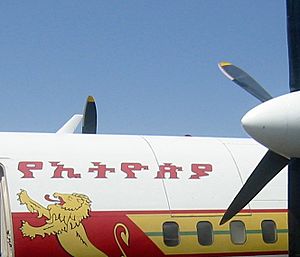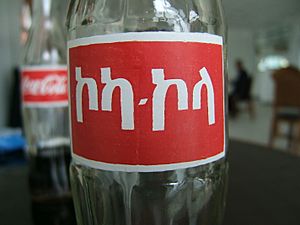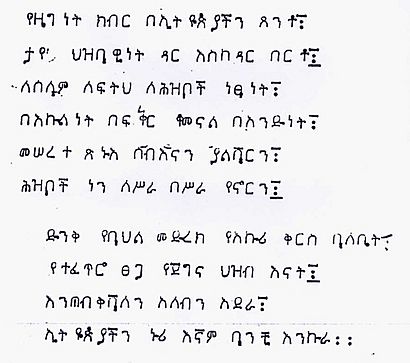Amharic language facts for kids
Quick facts for kids Amharic |
||||
|---|---|---|---|---|
| አማርኛ (Amarəñña) | ||||
Amharic script, fidäl, from Ge'ez script
|
||||
| Native to | Ethiopia | |||
| Ethnicity | Amhara | |||
| Native speakers | 32,000,000 (2018) L2 speakers: 25,000,000 |
|||
| Language family |
Afro-Asiatic
|
|||
| Writing system | Geʽez script (Amharic syllabary) Ge'ez Braille |
|||
| Official status | ||||
| Official language in | ||||
| Regulated by | Imperial Academy (former) | |||
| Linguasphere | 12-ACB-a | |||
|
||||
Amharic ( or (Amharic: አማርኛ), Amarəñña) is an Ethiopian Semitic language, which is a subgrouping within the Semitic branch of the Afroasiatic languages. It is spoken as a first language by the Amharas, and also serves as a lingua franca for all other populations residing in major cities and towns of Ethiopia.
The language serves as the official working language of the Ethiopian federal government, and is also the official or working language of several of Ethiopia's federal regions. It has over 31,800,000 mother-tongue speakers, with more than 25,100,000 second language speakers. Amharic is the most widely spoken language in Ethiopia, and the second most spoken mother-tongue in Ethiopia (after Oromo). Amharic is also the second largest Semitic language in the world (after Arabic).
Amharic is written left-to-right using a system that grew out of the Geʽez script. The segmental writing system in which consonant-vowel sequences are written as units is called an abugida (አቡጊዳ). The graphemes are called fidäl (ፊደል), which means "script", "alphabet", "letter", or "character".
There is no universally agreed-upon Romanization of Amharic into Latin script. The Amharic examples in the sections below use one system that is common among linguists specialising in Ethiopian Semitic languages.
Contents
Background
Amharic has been the official working language of Ethiopia, language of the courts, the language of trade and everyday communications and of the military since the late 12th century. The Amhara nobles supported the Zagwe prince Lalibela in his power struggle against his brothers which led him to make Amharic Lessana Negus as well as fill the Amhara nobles in the top positions of his Kingdom. While the appellation of "language of the king" (Ge'ez: ልሳነ ንጉሥ "Lisane Negus")/(Amharic: የንጉሥ ቋንቋ "Ye-Negus QwanQwa") and its use in the royal court are otherwise traced to the Amhara Emperor Yekuno Amlak. It is one of the official languages of Ethiopia, together with Oromo, Somali, Afar, and Tigrinya. Amharic is an Afro-Asiatic language of the Southwest Semitic group and is related to Geʽez, or Ethiopic, the liturgical language of the Ethiopian Orthodox church; Amharic is written in a slightly modified form of the alphabet used for writing the Geʽez language. There are 33 basic characters, each of which has seven forms depending on which vowel is to be pronounced in the syllable. Until 2020 Amharic was the sole official language of Ethiopia. The 2007 census reported that Amharic was spoken by 21.6 million native speakers in Ethiopia. More recent sources state the number of first-language speakers in 2018 as nearly 32 million, with another 25 million second-language speakers in Ethiopia. Additionally, 3 million emigrants outside of Ethiopia speak the language. Most of the Ethiopian Jewish communities in Ethiopia and Israel speak Amharic. In Washington DC, Amharic became one of the six non-English languages in the Language Access Act of 2004, which allows government services and education in Amharic. Furthermore, Amharic is considered a holy language by the Rastafari religion and is widely used among its followers worldwide.
Linguistic development theory
According to Donald Levine, the Afro-Asiatic language family likely arose either in the eastern Sahara or in southwestern Ethiopia. Early Afro-Asiatic populations speaking proto-Semitic, proto-Cushitic and proto-Omotic languages would have diverged by the fourth or fifth millennium BC. Shortly afterwards, the proto-Cushitic and proto-Omotic groups would have settled in the Ethiopian highlands, with the proto-Semitic speakers crossing the Sinai Peninsula into Asia Minor. A later return movement of peoples from South Arabia would have introduced the Semitic languages to Ethiopia. Based on archaeological evidence, the presence of Semitic speakers in the territory date to some time before 500 BC. Linguistic analysis suggests the presence of Semitic languages in Ethiopia as early as 2000 BC. Levine indicates that by the end of that millennium, the core inhabitants of Greater Ethiopia would have consisted of swarthy Caucasoid ("Afro-Mediterranean") agropastoralists speaking Afro-Asiatic languages of the Semitic, Cushitic and Omotic branches.
Other scholars such as Messay Kebede and Daniel E. Alemu argue that migration across the Red Sea was defined by reciprocal exchange, if it even occurred at all, and that Ethio-Semitic-speaking ethnic groups should not be characterized as foreign invaders.
Amharic is a South Ethio-Semitic language, along with Gurage, Harari, and others. Some time before the 1st century AD, the North and South branches of Ethio-Semitic diverged. Due to the social stratification of the time, the Cushitic Agaw adopted the South Ethio-Semitic language and eventually absorbed the Semitic population. Amharic thus developed with a Cushitic substratum and a Semitic superstratum. The northernmost South Ethio-Semitic speakers, or the proto-Amhara, remained in constant contact with their North Ethio-Semitic neighbors, evidenced by linguistic analysis and oral traditions. A 7th century southward shift of the center of gravity of the Kingdom of Aksum and the ensuing integration and Christianization of the proto-Amhara also resulted in a high prevalence of Geʽez sourced lexicon in Amharic. Some time after the 9th century AD, Amharic diverged from its closest relative, Argobba, probably due to religious differences as the Argobba adopted Islam.
In 1983, Lionel Bender proposed that Amharic may have been constructed as a pidgin as early as the 4th century AD to enable communication between Aksumite soldiers speaking Semitic, Cushitic, and Omotic languages, but this hypothesis has not garnered widespread acceptance. The preservation in Old Amharic of VSO word order and gutturals typical of Semitic languages, Cushitic influences shared with other Ethio-Semitic languages (especially those of the Southern branch), and the number of geographically distinct Cushitic languages that have influenced Amharic at different points in time (e.g. Oromo influence beginning in the 16th century) support a natural evolution of Amharic from a Proto-Ethio-Semitic language with considerable Cushitic influences (similar to Gurage, Tigrinya, etc.).
Writing system

The Amharic script is an abugida, and the graphemes of the Amharic writing system are called fidäl. It is derived from a modification of the Ge'ez script. Each character represents a consonant+vowel sequence, but the basic shape of each character is determined by the consonant, which is modified for the vowel. Some consonant phonemes are written by more than one series of characters: and (the last one has four distinct letter forms). This is because these fidäl originally represented distinct sounds, but phonological changes merged them. The citation form for each series is the consonant+ä form, i.e. the first column of the fidäl. The Amharic script is included in Unicode, and glyphs are included in fonts available with major operating systems.

Dialects
Not much has been published about Amharic dialect differences. All dialects are mutually intelligible, but certain minor variations are noted.
Mittwoch described a form of Amharic spoken by the descendants of Weyto language speakers, but it was likely not a dialect of Amharic so much as the result of incomplete language learning as the community shifted languages from Weyto to Amharic.
Literature
The oldest surviving examples of written Amharic date back to the reigns of the 14th century Emperor of Ethiopia Amda Seyon I and his successors, who commissioned a number of poems known as "የወታደሮች መዝሙር" (Soldier songs) glorifying them and their troops. There is a growing body of literature in Amharic in many genres. This literature includes government proclamations and records, educational books, religious material, novels, poetry, proverb collections, dictionaries (monolingual and bilingual), technical manuals, medical topics, etc. The Bible was first translated into Amharic by Abu Rumi in the early 19th century, but other translations of the Bible into Amharic have been done since. The most famous Amharic novel is Fiqir Iske Meqabir (transliterated various ways) by Haddis Alemayehu (1909–2003), translated into English by Sisay Ayenew with the title Love unto Crypt, published in 2005 (ISBN: 978-1-4184-9182-6).
Rastafari movement
The word Rastafari comes from Ras Täfäri, the pre-regnal title of Haile Selassie, composed of the Amharic words Ras (literally "Head", an Ethiopian title equivalent to duke) and Haile Selassie's pre-regnal name, Tafari.
Many Rastafarians learn Amharic as a second language, as they consider it to be sacred. After Haile Selassie's 1966 visit to Jamaica, study circles in Amharic were organized in Jamaica as part of the ongoing exploration of Pan-African identity and culture. Various reggae artists in the 1970s, including Ras Michael, Lincoln Thompson and Misty in Roots, have sung in Amharic, thus bringing the language to a wider audience. The Abyssinians, a reggae group, have also used Amharic, most notably in the song "Satta Massagana". The title was believed to mean "give thanks"; however, this phrase means "he thanked" or "he praised", as säṭṭä means "he gave", and amässägänä "thanks" or "praise". The correct way to say "give thanks" in Amharic is one word, misgana. The word "satta" has become a common expression in the Rastafari dialect of English, Iyaric, meaning "to sit down and partake".
Software
Amharic is supported on most major Linux distributions, including Fedora and Ubuntu.
The Amharic script is included in Unicode, in the Ethiopic block (U+1200 – U+137F). Nyala font is included on Windows 7 (see YouTube video) and Vista (Amharic Language Interface Pack) to display and edit using the Amharic Script. In February 2010, Microsoft released its Windows Vista operating system in Amharic, enabling Amharic speakers to use its operating system in their language.
Google added Amharic to its Language Tools which allows typing Amharic Script online without an Amharic Keyboard. Since 2004 Wikipedia has had an Amharic language Wiki that uses Ethiopic script.
See also
 In Spanish: Idioma amhárico para niños
In Spanish: Idioma amhárico para niños


